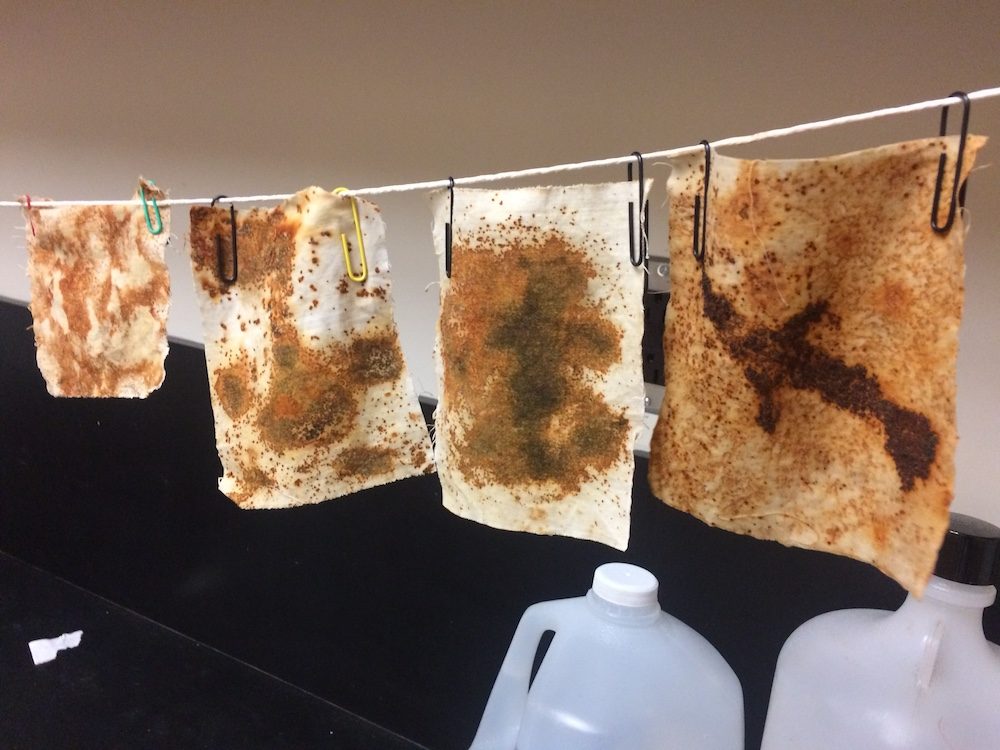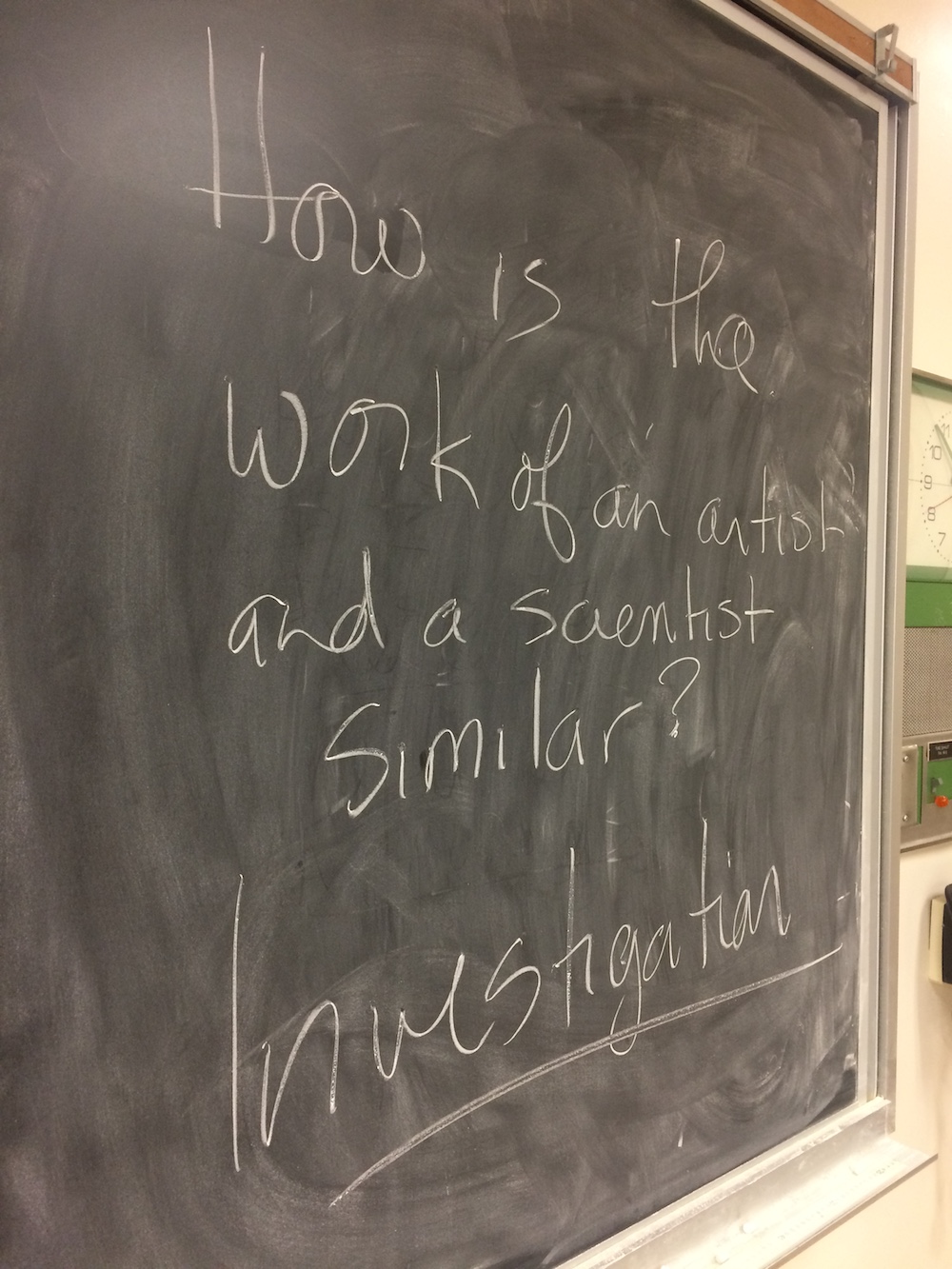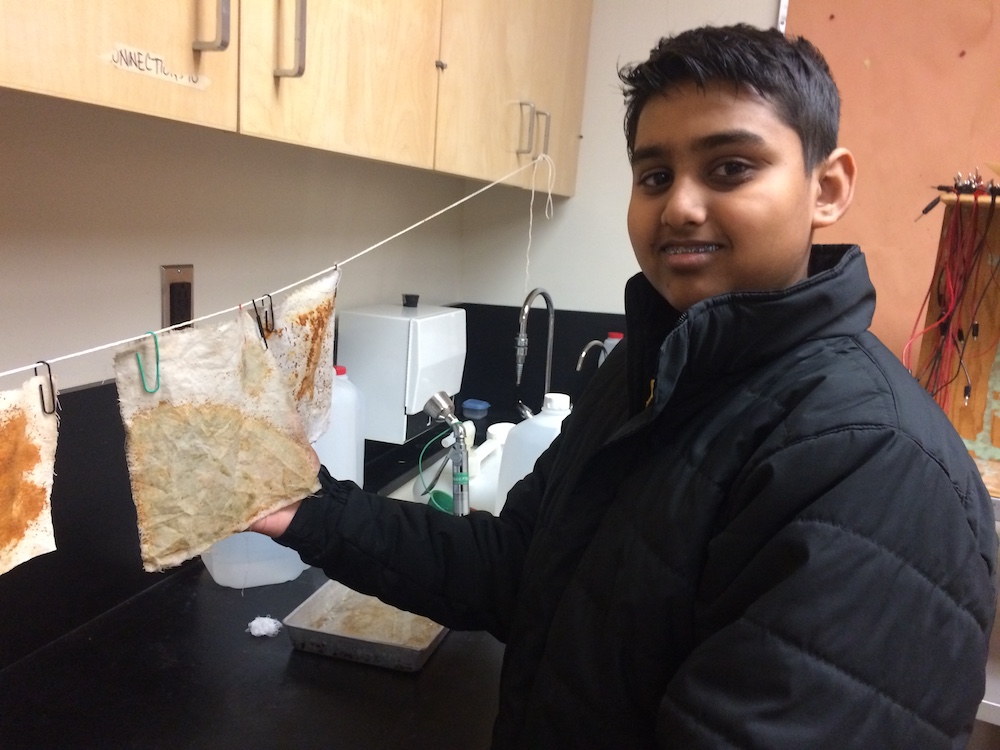“Artists and scientists alike begin their working projects and processes with a question—an inquiry. They are located within and asking questions of the same world. Processes and final manifestations of the work can differ greatly, yet goals may be parallel.”
—Beth Carruthers, 2006
“[Like] a scientist, an artist uses experimentation to think of different ways to make art. [In ninth-grade science class] we used different methods to make a picture with rust, [in] the same way [that] artists use different methods to make art.”
—Avi, student
As a high-school science teacher, I often am met with bewilderment when I introduce contemporary art into my classroom. My students usually humor me long enough to have some fun while learning and to see that art and science have a lot in common. Artists and scientists work in similar ways: asking questions, setting goals, testing, trying, failing, trying again, always learning, always asking more questions.
So we begin with a question. Real science always does.

Viking 1 orbiter image showing the thin atmosphere of Mars, 1976. Photo by NASA.
Why is Mars red?
My grade-9 applied science class is currently studying the exploration of space. We have looked at the solar system and how space missions have helped scientists begin to answer the multitude of questions about what lies beyond our planet. My class has been taking a close look at Mars and why humans want to go there. We have looked at the missions and rovers that have gathered data and images to help us better understand the red planet. Another unit of study we have this year is chemistry: elements, compounds, and chemical reactions. Rather than separate the two units, I am integrating them, and so we are looking at the chemistry of Mars.
So why is Martian soil red? My students didn’t take long to reach the answer: rust. We spent a little more time learning about the chemistry behind it: iron combines with oxygen to make iron oxide, two elements combine to create a compound, a chemical reaction takes place, and the color changes. Reactants lead to products, which lead to chemical changes. We learned the chemistry; now let’s do it!
How do artists and scientists work in similar ways?
My students didn’t just make rust; they created artworks from rust. In the process, they learned about investigation and how both artists and scientists work: through trial and error, analyze your process, and make it better.
Investigation: Leonardo Drew
We watched the Art in the Twenty-First Century Season 7 segment, Investigation, in which Leonardo Drew transforms raw materials through natural (and scientific) processes such as decay, oxidation, and exposure to weather. We discussed how Drew works like a scientist: improving on his previous work, experimenting with processes, making the next piece better and different.
Some of the guiding questions included:
- What did you like about Leonardo Drew’s sculptures?
- What do you think about the way he makes art?
- How does he use investigation in his work?
- How does he experiment when creating a piece?
- In what ways is Leonardo Drew like a scientist in his work?
- If he were to visit our classroom, what would you ask him?
- Leonardo Drew liked to ask, “What if…?” Consider our project. Ask a “What if…” question about your project and what you could do to change your process. What will you do differently on your next trial?
Using Science to Create Art
Esther Solondz is an artist interested in science and scientists. I came across her work when I was looking for ideas for my class’s study of the chemical process of oxidation and creating rust. Her work was a fabulous application of the rusting process. In her project The Evolution of Darwin (2008), Solondz creates portraits of scientists such as Charles Darwin and Marie Curie using rust. I adapted her process for my class (see the steps below) and had students use this chemical reaction to make their artworks.
The Process (Procedure)
Their task was to create an image representing something they learned about Mars, using the chemical reaction that creates rust (2Fe + O2 → 2FeO). We learned how a salt-water solution accelerates the oxidation process and connected that to the fact that the water on Mars would have been mostly salty. This would help to create the reddish-colored soil that we see in the images taken by NASA’s Curiosity rover and other missions.
First, the students soaked unbleached cotton fabric in a salt-water solution, created with table salt and tap water in proportions determined by the students. Then the fabric pieces were wrung out and placed in the bottom of a small tray (being in a science lab, we used dissection trays). Using fine iron filings and tools found in the science room (such as a scoopula or pipette), the students created images by sprinkling the filings onto the wet fabric and pushing the filings around. The salt-water solution made the iron filings stick to the fabric as they drew images that related to Mars and space travel. As a science teacher, I have easy access to iron filings through chemical suppliers, but steel wool would work as well, for teachers who might not be able to find iron filings. Some of my students plan to follow Esther Solondz’s example and use steel wool in their next trial.
We carefully added salt-water solution to the trays to immerse the cotton and iron. Sometimes the iron floated off the fabric, a problem for the students to solve in their next attempts. To change the intensity of the rust color, the students decided how long to leave their pieces in the solution. In subsequent trials, to see how the oxidation process was affected, some students chose to vary the time in the salt-water bath or to change the concentration of the salt solution.
Experimentation
“[After] seven years of just experimenting, this piece came out: Number 8. It was made of all the failures, or at least what I perceived as failures. If you have a Number 8, then that means 1 to 7 are no longer there; they are all a part of Number 8.“
—Leonardo Drew
My students spent a week experimenting, making observations, identifying what was working and what wasn’t working, and looking for ways to improve the process. They documented their successes and failures on their online portfolios (we use SesameSnap), adding photographs and reflections at each step in the process. They were artists and scientists at the same time. Lots of good scientific—and artistic—questions came up:
- How can we get a darker color?
- How can we stop the iron filings from floating away or smudging?
- How can we make finer lines?
- What do we do if the water dries up?
- How salty does the water need to be?
- How long should we leave it in the salt-water solution to get the best image?
A great discussion followed, about how artists must get frustrated when their experiments don’t work. We discussed how both artists and scientists meet with failure and use those opportunities to learn. The students did a second trial, changing one or more variables to see how their images changed. Some of their modifications worked, and some didn’t, but they all learned a lot about science and art and investigation.
My young scientist-artists are now working on their third trial. They are putting their new ideas to work, trying to get just the right effect. They don’t want to stop there, however. They plan to visit the grade-12 visual-art class, to teach those students the process and the science. An interdisciplinary collaboration lies ahead!
Learning Goals:
- Students will make connections between exploration, investigation, and creation.
- Students will assess the creation and use of a chemical compound.
- Students will see different ways evidence can be used by various modes of thinking.
Resources:
Wyckoff, Mick. “Art as Science Project: The Evolution of Charles Darwin by Esther Solondz.” Evolution: Education and Outreach 1, no. 2 (April 2008): 210–22. Accessed April 28, 2017.
Carruthers, Beth. “Mapping the Terrain of Contemporary EcoArt Practice and Collaboration,” Art in Ecology: A Think Tank on Arts and Sustainability, Vancouver, British Columbia, April 2006. Accessed April 28, 2017.
Investigation. Art in the Twenty-First Century, Season 7, October 2014.
My Lesson Summary Google Slide presentation
All photos courtesy of the author.








